Missed Opportunities: A Chance to Develop Synergy Between Humanitarian Mine Action and Humanitarian Forensic Action
By Patrick Nowak [ American Military University ]
CISR JournalTThis article is brought to you by the Center for International Stabilization and Recovery (CISR) from issue 25.3 of The Journal of Conventional Weapons Destruction available on the JMU Scholarly Commons and Issuu.com.
This article aims to identify the opportunities for synergy that exist globally between humanitarian mine action (HMA) and humanitarian forensic action (HFA) through the lens of their specific objectives. Moreover, it recommends how best to leverage existing touchpoints and establish networks between the two disciplines; explores the access and placement that can enhance both mine action and forensic objectives; shows how subject-matter experts currently remain underutilized in explosive mitigation missions and human remains recovery operations; and indicates how to remedy that through combined efforts.
For those who have worked in an HMA capacity in post-conflict zones, it is not uncommon to encounter the remains of those who were embroiled in the original conflict and perished. These encounters pose unique challenges to HMA specialists who are not explicitly trained in managing corpses, identifying remains, or the ethical and legal standards for adequately dealing with remains. Additionally, dealing with these challenges far exceeds the scope of work typically outlined in HMA operations.
Fortunately, HFA is an emerging discipline that specifically provides for the tasking and training of individuals to deal with this kind of work. However, similar to HMA specialists, HFA personnel may lack the requisite skills and training to recover human remains within an environment contaminated with explosives. Ultimately, these disciplines are not mutually exclusive, both crossing the line of each other’s missions, specifically within the post-conflict operating environment. Unfortunately, because HMA and HFA are two separate disciplines with separately stated objectives, current efforts remain stove-piped within their respective disciplines, which can reduce the overall effectiveness of both. However, interoperability opportunities exist to provide holistic benefits to both HMA and HFA missions by utilizing specialized personnel to provide a more significant impact to the populations these organizations are attempting to support.
HMA: Not Simply a Clearance Operation
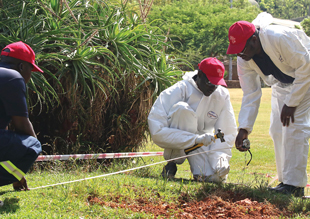
The ICRC conducts training at the African School for Humanitarian Forensic Action. Image courtesy of the ICRC.
HMA is a unique and dangerous job that requires specialized training and experience to conduct safely. Multiple organizations around the globe support HMA operations, such as the U.S. Department of Defense (DoD), nongovernmental organizations (NGOs), and intergovernmental organizations (IGOs), each with specific authorities and slightly different missions. For instance, the U.S. Department of Defense can supply conventional forces to support “nations plagued by land mines and Explosive Remnants of War (ERW) by executing ‘train-the-trainer’ programs of instruction designed to develop indigenous capabilities for a wide range of HMA activities.”1 Within the authorities outlined in CJCSI 3702.01C, U.S. military forces engaged in HMA operations “may not engage in the physical detection, lifting, or destroying of land mines, or stockpiled munitions, or other ERW, unless it is done for the concurrent purpose of supporting US military operations.”1 Conversely, NGOs and IGOs have the authority to train and assist host nations in the physical detection and disposal of ERW and landmines to include education, stockpile destruction, victim assistance, survey, mapping, and marking functions.2 The responsibilities that HMA organizations have are outlined in the United Nations Mine Action Service’s (UNMAS) five pillars of mine action.3 Additionally, international humanitarian law (IHL) and human rights law establish the legal foundation for mine action, with several other treaties, policies, and conventions providing additional guidance.3 Even though some HMA activities are limited in their capacity to assist nations, the overall goal of relieving human suffering by reducing the social, economic, and environmental impact from ERW and landmines is common throughout all HMA activities.2,4
However, notably absent in these guiding instructions are requirements or obligations to deal with corpses or human remains. Because a significant number of HMA operations deal with post-conflict zones, the likelihood of encountering human remains and corpses is high. The HMA mission then becomes more than just a clearance operation, and additional organizations that specialize in the management and identification of the deceased are required.
HFA: Hazards of the Job
Like HMA, HFA is a difficult job requiring highly specialized training and experience. According to Cordner and Tidball-Binz,5 the field of HFA originated from the Katyn Forest Massacre in World War II, utilizing forensic science to evaluate the mass killings that took place there. More recently, the Argentine Forensic Anthropology Team (EAAF), an NGO created in the 1980s after a violent regime change in Argentina, was established to locate “the disappeared” and supply answers to the families who lost their loved ones.5,6 The work of the EEAF, American Association of the Advancement of Science (AAAS), and Dr. Snow marked the beginning of modern-day humanitarian forensic action.7
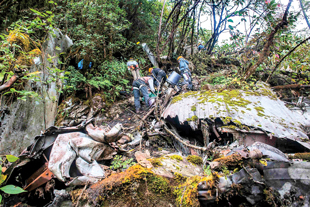
Members of the DPAA conducting search and recovery efforts in the area of a B-24J crash site in Arunachal Pradesh, India. Image courtesy of SSgt Erik Cardenas, U.S. Air Force.
Currently, the leading global organization for HFA is the International Committee of the Red Cross (ICRC). The ICRC defines humanitarian forensics as the “application of forensic science to humanitarian activities that seek to alleviate human suffering and protect the dignity of all victims of armed conflict and catastrophes, framed under International Humanitarian Law and Human Rights Law.5 HFA’s foundation is built upon these two international laws and their mission follows five pillars: (1) “the dignity of the dead must be respected; (2) families have a right to know the fate of their relatives; (3) religion, belief, and culture must be respected; (4) the right to health must be protected; (5) and serious violation of international humanitarian law and international crimes must be prosecuted.”8
Alongside these five pillars, the ICRC has the specific mission of training host nation counterparts and establishing forensic capabilities within host nations.9 As a testament to humanitarian forensics’ roots and the work of Dr. Snow in developing the EAAF, this mission continues today. Unfortunately, a significant driving force behind ICRC training and advisory mission is the nearly constant conflict happening around the globe.10,11 However, the ICRC has significantly contributed to worldwide forensic programs through its advisement and promotion of best standards of practice.11 Organizations like the ICRC increase their global capacity to support humanitarian forensics by building indigenous capabilities within nations.
Due to the nature of their work, HFA specialists work extensively in explosively contaminated areas, typically those emerging from conflict.11 There is a significant risk to forensic specialists when working in these environments. Humanitarian forensic specialists do not possess the required training and expertise to deal with explosive threats and are severely hampered in their ability to work in these environments. Forensic scientists assume unnecessary risk in completing their mission without the assistance of specially trained explosive ordnance disposal (EOD) technicians.
Along with the ICRC—NGOs, IGOs, and nationally affiliated defense organizations provide humanitarian forensic efforts in support of alleviating human suffering. Notably, the U.S. Defense POW/MIA Accounting Agency (DPAA) is the responsible organization for recovering, identifying, and returning the remains of U.S. service members unaccounted for or killed in conflict.12 In many cases, DPAA requests the assistance of military EOD and NGOs to ensure the appropriate handling of unexploded ordnance (UXO) at suspected human remains sites, highlighting the need for synergy between forensic specialists and mine disposal experts.
Aligned Objectives: The Same, but Different
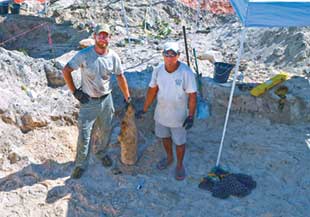
Personnel from the QRF and Kiribati Police Service (KPS) recover ERW. Image courtesy of GWHF.
At their foundation, both HMA and HFA are governed by the same laws: IHL and human rights laws. However, they vary slightly by treaty, policy, and convention; and the forensic evidence found around human remains can be used as evidence to support criminal cases, investigations, or allegations of IHL violations.
Still, it is apparent that there are many similarities in the ultimate objectives of HMA and HFA, with their primary mission of relieving human suffering being the same. Because of this, it becomes significantly easier to develop synergy between these two disciplines. For instance, DoD HMA and ICRC HFA possess similar goals of training host nations to build an organic capability.8,9 Mikellide expands upon this, stating that training and establishing local forensic capabilities that provide sustainable solutions to humanitarian issues is a key objective of the ICRC.10 Though these separate organizations have different ways and means to achieve their ends, their ends go hand in hand with one another. Let us briefly look at a specific case study that demonstrates the aligned objectives of HMA and HFA, the synergy used to complete the mission, and the challenges posed in the current humanitarian action environment.
Kiribati: A Case Study
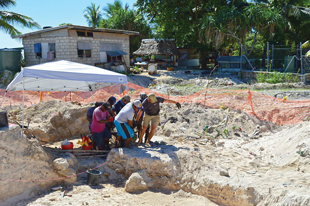
Personnel from the QRF and KPS remove ordnance from the site for disposal. Image courtesy of GWHF.
In 2016, the Office of Weapons Removal and Abatement in the U.S. Department of State’s Bureau of Political-Military Affairs (PM/WRA) deployed its Quick Reaction Force (QRF) managed by the Golden West Humanitarian Foundation (GWHF) to Tarawa to assist the government of Kiribati with the safe disposal of ERW. On two occasions during the eleven-month operation, human remains were located in the excavation and UXO sites.13 The overall mission for GWHF did not specify how to deal with human remains, and the QRF personnel had no training or expertise in handling these situations. In order to properly manage the discovered remains, the QRF reached out to the U.S. Embassy in Suva who coordinated with DPAA to travel to the site and conduct HFA activities in support of the QRF. Significant logistical hurdles, resourcing, and extensive time delays precluded DPAA from being able to travel to the Kiribati site and assist with the human remains recovery. Fortunately, and in a completely uncoordinated and separate effort, History Flight, a U.S. humanitarian forensics NGO, was also operating in the local area, recovering human remains from a Tarawa plane crash site, and GWHF QRF personnel were able to reach out to the team and quickly coordinate efforts. U.S. Army Col. (ret) Allan Vosburgh, Chief Executive Officer of GWHF, stated “Luckily, we had access to a trained anthropologist, schooled in recovery of human remains, from an organization engaged in recovering a plane crash site. We took care of their UXO, and they took the bones off our hands. That is unusual, and we are frequently left to our own devices.”
Charged with the management of the remains and due to DPAA’s logistical issues, DPAA attempted to coordinate with History Flight to provide assistance. However, according to the Golden West QRF final report , the presence of human remains and a lack of coordination and cooperation between the HFA NGO and DPAA had a significant impact on the HMA operation.13 This lack of coordination led to extensive periods where work could not be conducted by GWHF QRF personnel, extending the overall operation and exposing personnel to risk for a greater period of time than necessary. The complex working environment precluded DPAA personnel from being on scene and ultimately turned over custody of the scene to History Flight to assist GWHF QRF in managing the human remains.13 Not everything was doom and gloom, however. Personnel on the ground were able to find solutions by gaining the authority to work together and continuing to carry out HMA work in areas of the site that did not contain human remains, expediting the process. Additionally, having both HMA and HFA organizations working together demonstrated the potential usefulness of integrated and co-located humanitarian action forces to achieve their missions.
Existing Synergy: The Building Blocks of Something Great
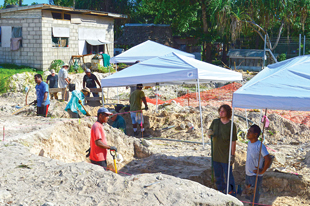
History Flight recovering human remains from the site. Image courtesy of GWHF.
The Kiribati case study demonstrates some of the existing synergy between HMA and HFA operations. The current environment of humanitarian action is complex and profoundly challenging and needs innovative organizations to find solutions to save lives and provide answers to awaiting families.10 When the opportunity presents itself, working collaboratively satisfies the goals of both disciplines. In this instance, the ability to leverage existing touchpoints between NGOs, the U.S. Department of State, and the U.S. Department of Defense allowed synergy to occur and resulted in mission success. Touchpoints like these exist throughout the HMA and HFA enterprise but remain primarily stove piped within their discipline. As an example, military EOD units work extensively with HMA NGOs and have minimal interaction with DPAA, which falls under the HFA umbrella. By fostering relationships between disciplines, HMA and HFA can better synergize and benefit from each other’s strengths.
More importantly, this case study highlights the challenges that currently exist between the two disciplines. First, interdisciplinary touchpoints are lacking. As noted, communication within disciplines exists to a greater extent, but to create synergy with one another, more consistent and lasting connections will be needed. Second, operational knowledge of other organizations’ activities, specifically cross-disciplinary, is minimal. Imagine if GWHF had prior knowledge of the HFA NGO operating in the area and could have precoordinated a human remains response package with authorities already previously aligned.
Recommendations: The Foundation for Greatness
A first step to developing synergy within these fields is to provide standardized, collaborative training. Locations that possess a repository of EOD/HMA knowledge and forensics science are a logical first step to begin developing opportunities for synergy. Oklahoma State University is home to the Institute for Global Explosive Hazard Mitigation and the School of Forensic Science, both nested under the Center for Health Sciences. The requisite knowledge to blend these two skills resides here and presents a golden opportunity for practitioners to come together to train and exchange skills to succeed in a challenging job and environment. In this setting, EOD/HMA operators can learn foundational skills to manage dead bodies and human remains while conducting explosive hazard mitigation operations from knowledgeable faculty and forensic specialist practitioners in the course. This could include actions to be taken when remains are discovered, the ethical norms and legal standards and due respect to managing the dead, and how best to assist forensic technicians in the field.
Forensic scientists can also be taught the hazards and associated safeties when working with or near explosives. This can include how to identify explosive threats, remain safe in an explosive environment, and “mark and bypass” these threats as not to limit the overall HFA mission. This kind of subject-matter expert exchange would be crucial to understanding each other’s tactics, techniques, and procedures—ultimately reducing the time of HMA and HFA operations. A direct affiliation with academia will also provide innovative solutions for HMA and HFA organizations to produce greater results.
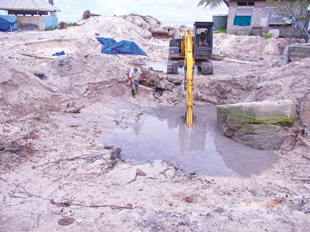
Human remains discovered, covered, and cordoned during ERW excavation of the site.Image courtesy of GWHF.
A second step is to leverage current touchpoints between the HMA and HFA fields and establish new interdisciplinary contacts to develop operational networks that can communicate and interoperate. A central repository of knowledge and training, as noted previously, would significantly accelerate, grow, and strengthen the network and enable synergy. Habitual and consistent relationships by enduring organizations, notably embedded NGOs, could act as the glue needed to create networks and provide credibility with host nations. It is essential when working with host nations to have credible relations that have been established over an extended period and through repeated iterations of training or operations. This is especially true if conducting cross-disciplinary engagements. In a post-conflict environment where the local population is grieving losses and looking for answers about their loved ones, they may not be receptive to HMA organizations that could be perceived to be associated with military forces. Suppose an HFA organization had access and placement to this area and already established solid and credible relationships. In that case, the local population could be more accepting of the HMA organizations, allowing them to conduct their operations and ultimately reduce additional suffering.
This is not to say a centralized organization needs to be created and would be tasking all HFA and HMA operations. Combined task forces would be a unity of effort within the HMA and HFA disciplines to utilize the networks established to solve complex problems in challenging environments. Significant hurdles exist to include resourcing and authorities. However, as demonstrated in the Kiribati case study, solutions—such as coordinating with the authority to continue work after the discovery of human remains and identifying how best to make continued progress at HMA and HFA sites—can be reached to achieve mission success. This is also a total understanding of the capabilities others possess to best fit the specified mission. One major consideration is the access and placement that so many HMA and HFA organizations already have. Leveraging the network could alleviate considerable operational constraints and restraints through another entity’s knowledge of the operating environment.
Conclusion
Though HMA and HFA are separate disciplines, their spheres of operations overlap and share many of the same humanitarian goals. Despite the challenges, existing synergy provides a solid foothold for new opportunities for collaboration, which are readily available and ripe for action. Working together will keep HMA and HFA specialists safe and within ethical and legal bounds, ensuring greater and more efficient successes in achieving desired outcomes. However, cooperation between HFA and HMA can only be achieved if fostered and developed. Opportunities for networking, cross-training, and interoperating should be paramount for both disciplines. Ultimately, developing collaboration between these two disciplines creates a framework for interoperability between all humanitarian action groups. Opportunities already exist with disciplines such as forensic anthropology and archeology at historical or sacred sites.7 This is only the beginning, and who knows what additional opportunities for synergy will arise. ◊
 Patrick Nowak
Patrick Nowak
Doctoral Candidate
American Military University
Patrick Nowak is an active duty Navy Explosive Ordnance Disposal Officer and doctoral candidate in Global Security at American Military University. His previous graduate studies include an MA in Management with a concentration in Organizational Leadership.

